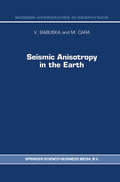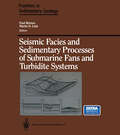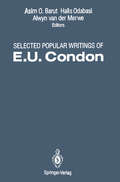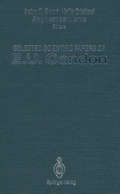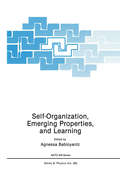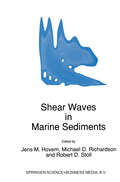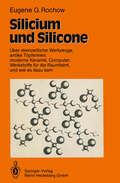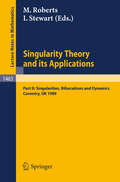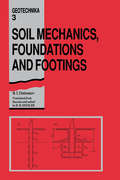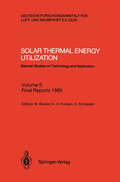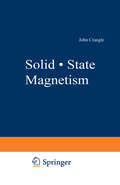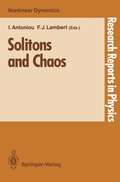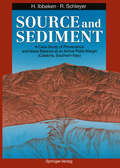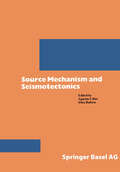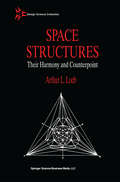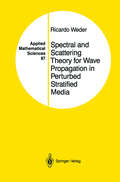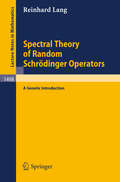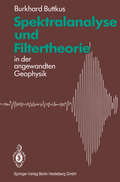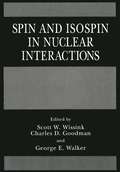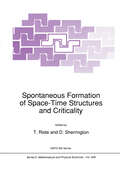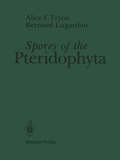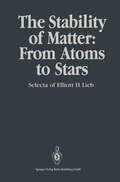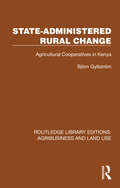- Table View
- List View
Seismic Facies and Sedimentary Processes of Submarine Fans and Turbidite Systems (Frontiers in Sedimentary Geology)
by Paul Weimer Martin H. LinkThe Frontiers in Sedimentary Geology series was established for the student, the researcher, and the applied scientist to enhance their potential to stay abreast of the most recent ideas and developments and to become familiar with certain topics in the field of sedimentary geology. This series deals with subjects that are in the forefront of both scientific and economic interests. The treatment of a subject in an individual volume, therefore, should be a combina tion of topical, regional, and interdisciplinary approaches. The interdisciplinary aspects are becoming more and more important because most studies dealing with the natural sciences cannot effectively stand alone. Although this thrust may sound simple, in reality it is not, basi cally because each discipline has developed its own jargon and definitions ofterms. Communi cation among disciplines is a major issue and can be accomplished more constructively when people with different backgrounds join together at the same symposium and can read from the same volume rather than confining themselves within the world of their own specialty meetings and journals. Books in this series provide this connective link between disciplines. Each book in this series provides a continuous and connected flow of concepts throughout the volume by the use of introductory chapters that outline a topic to help the reader grasp its problems and to understand the contributions that follow.
Selected Popular Writings of E.U. Condon
by E.U. Condon0 e The selected popular writings contain articles he wrote on technical topics for such journals as The American Journal of Physics, Science, and Nature, as well as reflections on education, UFO's, and other topics.
Selected Scientific Papers of E.U. Condon
by E.U. CondonE.U. Condon's major contributions were in atomic and molecular physics and spectroscopy; his book with G.H. Shortley on The Theory of Atomic Spectra dominated the field of spectroscopy for half a century and remains an invaluable reference. He also played an important role in the institutions of American science. He served for many years as the editor of Reviews of Modern Physics, and with Hugh Odishaw he edited the still widely used Handbook of Physics. After World War II, Condon became director of the National Bureau of Standards (now NIST), and helped to make it one of the premier research laboratories in the physical sciences in the world. The Selected Scientific Papers reprint many of the most important contributions Condon made to atomic physics, quantum theory, nuclear physics, condensed-matter physics and other fields. The Selected Popular Writings contain articles he wrote on technical topics for such journals as The American Journal of Physics, Science, and Nature, as well as reflections on education, UFO's, and other topics.
Self-Organization, Emerging Properties, and Learning (Nato Science Series B: #260)
by Agnessa BabloyantzThis volume contains the proceedings of the workshop held in March 1990 at Austin, Texas on Self-Organization, Emerging Properties and Learning. The workshop was co-sponsored by NATO Scientific Affairs Division, Solvay Institutes of Physics and Chemistry, the University of Texas at Austin and IC2 Institute at Austin. It gathered representatives from a large spectrum of scientific endeavour. The subject matter of self-organization extends over several fields such as hydrodynamics, chemistry, biology, neural networks and social sciences. Several key concepts are common to all these different disciplines. In general the self-organization processes in these fields are described in the framework of the nonlinear dynamics, which also governs the mechanisms underlying the learning processes. Because of this common language, it is expected that any progress in one area could benefit other fields, thus a beneficial cross fertilization may result. In last two decades many workshops and conferences had been organized in various specific fields dealing with self-organization and emerging properties of systems. The aim of the workshop in Austin was to bring together researchers from seemingly unrelated areas and interested in self-organization, emerg{ng properties and learning capabilities of interconnected multi-unit systems. The hope was to initiate interesting exchange and lively discussions. The expectations of the organiziers are materialized in this unusual collection of papers, which brings together in a single volume representative research from many related fields. Thus this volume gives to the reader a wider perspective over the generality and ramifications of the key concepts of self organization.
Shear Waves in Marine Sediments
by J. M Hovem Michael D. Richardson Robert D. StollShear waves and closely related interface waves (Rayleigh, Stoneley and Scholte) play an important role in many areas of engineering, geophysics and underwater acoustics. In some cases interest is focused on large-amplitude waves of low frequency such as those associ ated with earthquakes and nuclear explosions; in other cases low amplitude waves, which have often travelled great distances through the sediment, are of interest. Both low and high frequency shear and interface waves are often used for seafloor probing and sediment characterization. As a result of the wide spectrum of different interests, different disciplines have developed lines of research and a literature particularly suited to their own problems. For example water-column acousticians view the seafloor sediment as the lower boundary of their domain and are interested in shear and interface waves in the near bottom sediments mainly from the standpoint of how they influence absorption and reflection at this boundary. On the other hand, geophysicists seeking deep oil deposits are interested in the maximum penetration into the sediments and the tell-tale characteristics of the seismic waves that have encountered potential oil or gas bearing strata. In another area, geotechnical engineers use shear and interface waves to study soil properties necessary for the design and the siting of seafloor structures.
Silicium und Silicone: Über steinzeitliche Werkzeuge, antike Töpfereien, moderne Keramik, Computer, Werkstoffe für die Raumfahrt, und wie es dazu kam
by Eugene G. RochowEugene G. Rochow, Prof. emerit. der Harvard Universität, führte am 10. Mai 1940 ein Laborexperiment durch, das für die industrielle Produktion von Siliconen von grundlegender Bedeutung war: die Rochow-Synthese. Durch diese Synthese wurden die "Wundermaterialien" zugänglich für viele Anwendungen zur Verbesserung von Gebrauchsgegenständen, zur Miniaturisierung von elektronischen Bauelementen und zur Herstellung von Raumanzügen für Astronauten, die die extreme Hitze und Kälte auf dem Mond aushielten.
Singularity Theory and its Applications: Warwick 1989, Part II: Singularities, Bifurcations and Dynamics (Lecture Notes in Mathematics #1463)
by Mark Roberts Ian StewartA workshop on Singularities, Bifuraction and Dynamics was held at Warwick in July 1989, as part of a year-long symposium on Singularity Theory and its applications. The proceedings fall into two halves: Volume I mainly on connections with algebraic geometry and volume II on connections with dynamical systems theory, bifurcation theory and applications in the sciences. The papers are original research, stimulated by the symposium and workshop: All have been refereed and none will appear elsewhere. The main topic of volume II is new methods for the study of bifurcations in nonlinear dynamical systems, and applications of these.
Soil Mechanics, Footings and Foundations: Geotechnika - Selected Translations of Russian Geotechnical Literature 3
by B.I. DalmatovTranslated from the second Russian edition of 1988. Parts 2, "Soil mechanics" and 3, "Foundations and footings" are revised and updated versions of the first Russian edition of 1981. Part 1, "Special course in engineering geology," contains a discussion of physicomechanical properties of soil, geody
Soil Mechanics, Footings and Foundations: Geotechnika - Selected Translations of Russian Geotechnical Literature 3
by B.I. DalmatovTranslated from the second Russian edition of 1988. Parts 2, "Soil mechanics" and 3, "Foundations and footings" are revised and updated versions of the first Russian edition of 1981. Part 1, "Special course in engineering geology," contains a discussion of physicomechanical properties of soil, geody
Solar Thermal Energy Utilization: German Studies on Technology and Application
by Manfred Becker Karl-Heinz Funken Gernot SchneiderSolid · State Magnetism
by John CrangleSolid state magnetism is important and attempts to understand magnetic properties have led to an increasingly deep insight into the fundamental make up of solids. Both experimental and theoretical research into magnetism continue to be very active, yet there is still much ground to cover before there can be a full understanding. There is a strong interplay between the developments of materials science and of magnetism. Hundreds of new materials have been dis covered, often with previously unobserved and puzzling magnetic prop erties. A large and growing technology exists that is based on the magnetic properties of materials. Very many devices used in everyday life involve magnetism and new applications are being invented all the time. Under standing the fundamental background to the applications is vital to using and developing them. The aim of this book is to provide a simple, up-to-date introduction to the study of solid state magnetism, both intrinsic and technical. It is designed to meet the needs and interests of advanced undergraduate students reading physics; of postgraduates in physical and materials sciences and in engineering; and also those of the practising scientist specializing in another area who requires an introduction to magnetism.
Solitons and Chaos (Research Reports in Physics)
by Ioannis Antoniou Franklin J. Lambert"Solitons and Chaos" is a response to the growing interest in systems exhibiting these two complementary manifestations of nonlinearity. The papers cover a wide range of topics but share common mathematical notions and investigation techniques. An introductory note on eight concepts of integrability has been added as a guide for the uninitiated reader. Both specialists and graduate students will find this update on the state ofthe art useful. Key points: chaos vs. integrability; solitons: theory and applications; dissipative systems; Hamiltonian systems; maps and cascades; direct vs. inverse methods; higher dimensions; Lie groups, Painleve analysis, numerical algorithms; pertubation methods.
Source and Sediment: A Case Study of Provenance and Mass Balance at an Active Plate Margin (Calabria, Southern Italy)
by Hillert Ibbeken Ruprecht SchleyerDeciphering provenance - this is the study of how far geology, geomorphology and climate of a source, a mountainous area, may be reconstructable from its erosional products released to the sea; from gravel and sand, from silt, sand, clay which recombine to form a new cycle of rocks. The purpose of this book is to give a quantitative picture of both source and sediment and the masses involved in the flux of material; based on a modern case study in Calabria, southern Italy, a mountain range which is part of an active plate margin. High erosion rates in the past (200mm/ka), and dramatic ones at present (1500mm/ka), make the area a powerful source of sediment comparable to orogenic conditions of the geological past. The book presents the first systematic, quantitative and data-bank supported study - here a larger source with small rivers and their sedimentary products - of the complex topic of provenance of terrigenous sediments and related mass balances at an active plate margin. It may serve as an orientation for corresponding research in other plate tectonic realms.
Source Mechanism and Seismotectonics (Pageoph Topical Volumes)
by UDIAS BUFORNnesus, Armenia, and Georgia have largely profited from the experience acquired in the study of the large events of the early 1980s. The Mediterranean region is not only the site of shallow dispersed seismic activity, it is also the site of localized intermediate depth seismic activity, and of some rare deeper events. Active subduc tion is clearly at the origin of Greek intermediate depth seismicity, while the deep activity under Calabria and the Vrancea region in Romania is clearly related to downgoing slabs that have long remained active after the arrest of subduction. The origin of the intermediate and very deep seismicity below Spain is a considerably more complex problem. Several possible explanations of the intermediate depth activity to about 110 km have been proposed, but the origin of the deep (650 km) events studied by BURFORN et a1. remains a mystery since this is the only source of deep activity that is not related in an obvious way to a subduction zone. The problem of seismic source mechanism and seismotectonics cannot be completely separated from that of the mechanical origin of earthquakes. Recent work on this subject has revealed the intimate relation between fault geometry, as observed by field geologists, and the results of inversion of source process from seismic data in the far-field or in the near-field.
Space Structures (Design Science Collection)
by A. Loebxiv aggregates: this touches on the very nature of things. The concept of statistical symmetry which Loeb develops is particularly important, it emphasizes the limitations in seemingly random aggregates and for permits general statements of which the crystallographer's sym metries are only special cases. The reductionist and holistic approaches to the world have been at war with each other since the times of the Greek philosophers and before. In nature, parts clearly do fit together into real structures, and the parts are affected by their environment. The problem is one of understanding. The mystery that remains lies largely in the nature of structural hierarchy, for the human mind can examine nature on many different scales sequentially but not simultaneously. Arthur Loeb's monograph is a fundamental one, but one can sense a devel opment from the relations between his zero-and three-dimensional cells to the far more complex world of organisms and concepts. It is structure that makes the difference between a cornfield and a cake, between an aggregate of cells and a human being, between a random group of human beings and a society. We can perceive anything only when we perceive its structure, and we think by structural analogy and comparison. Several books have been published showing the beauty of form in nature. This one has the beauty of a work of art, but it grows out of rigorous mathematics and from the simplest of bases-dimensional ity, extent and valency.
Spectral and Scattering Theory for Wave Propagation in Perturbed Stratified Media (Applied Mathematical Sciences #87)
by Ricardo WederThe propagation of acoustic and electromagnetic waves in stratified media is a subject that has profound implications in many areas of applied physics and in engineering, just to mention a few, in ocean acoustics, integrated optics, and wave guides. See for example Tolstoy and Clay 1966, Marcuse 1974, and Brekhovskikh 1980. As is well known, stratified media, that is to say media whose physical properties depend on a single coordinate, can produce guided waves that propagate in directions orthogonal to that of stratification, in addition to the free waves that propagate as in homogeneous media. When the stratified media are perturbed, that is to say when locally the physical properties of the media depend upon all of the coordinates, the free and guided waves are no longer solutions to the appropriate wave equations, and this leads to a rich pattern of wave propagation that involves the scattering of the free and guided waves among each other, and with the perturbation. These phenomena have many implications in applied physics and engineering, such as in the transmission and reflexion of guided waves by the perturbation, interference between guided waves, and energy losses in open wave guides due to radiation. The subject matter of this monograph is the study of these phenomena.
Spectral Theory of Random Schrödinger Operators: A Genetic Introduction (Lecture Notes in Mathematics #1498)
by Reinhard LangThe interplay between the spectral theory of Schr|dinger operators and probabilistic considerations forms the main theme of these notes, written for the non-specialist reader and intended to provide a brief and elementaryintroduction to this field. An attempt is made to show basic ideas in statu nascendi and to follow their evaluation from simple beginnings through to more advanced results. The term "genetic" in the title refers to this proceedure. The author concentrates on 2 topics which, in the history of the subject, have been of major conceptual importance - on the one hand the Laplacian is a random medium and the left end of its spectrum (leading to large deviation problems for Brownian motion and the link to thenotion of entropy) and on the other, Schr|dinger operators with general ergodic potentials in one-dimensional space. Ideas and concepts are explained in the simplest, possible setting and by means of a few characteristic problems with heuristic arguments preceding rigorous proofs.
Spin and Isospin in Nuclear Interactions
by C. D. Goodman G. E. Walker S. W. WissinkThis volume contains the proceedings of an International Conference on "Spin and Isospin in Nuclear Interactions", which was held in Telluride, Colorado USA, 11-15 March 1991. This was the fifth in a series of conferences held in Telluride every three years since 1979. In attendance at the conference were just under 100 participants, representing a total of 43 institutes from 12 different countries. In keeping with previous Telluride conferences, the role of spin and isospin degrees of freedom in both nuclear structure and nuclear interactions remained an important theme. Topics covered included new results on the spin- and isospin-dependent terms in the free and effective nucleon-nucleon interaction, Gamow-Teller excitations, charge and spin exchange with hadronic probes, and spin measurements with leptonic probes. Recent progress in the development of polarized sources, polarized targets, and po larimetry was also discussed, as were applications to neutrino physics and astrophysics. Whereas earlier Telluride conferences had dealt primarily with nucleon-nucleus inter actions, this meeting included extensive discussions on the role of spin and flavor in particle interactions, and on ways of "bridging the gap" between concepts usually as sociated with particle physics and the domain of more conventional nuclear physics. The conference consisted of morning and evening scientific sessions, leaving the afternoons free for informal discussions, recreation, and enjoyment of the scenic beauty of the Telluride area. In addition to the invited talks, time was allotted for contributed talks on new results.
Spontaneous Formation of Space-Time Structures and Criticality (Nato Science Series C: #349)
by T. Riste David SherringtonThis volume contains the proceedings of a NATO Advanced study Institute held at Geilo, Norway between 2 - 12 april 1991. This institute was the eleventh in a series held biannually at Geilo on the subject of phase transitions. It was intended to capture the latest ideas on selforgan ized patterns and criticality. The Institute brought together many lecturers, students and active re searchers in the field from a wide range of NATO and non-NATO countries. The main financial support came from the NATO scientific Affairs Divi sion, but additional support was obtained from the Norwegian Research Council for Science and the Humanities (NAVF) and Institutt for energi teknikk. The organizers would like to thank all these contributors for their help in promoting an exciting and rewarding meeting, and in doing so are confident that they echo the appreciation of all the parti cipants. In cooperative, equilibrium systems, physical states are described by spatio-temporal correlation functions. The intimate connection between space and time correlations is especially apparent at the critical point, the second order phase transition, where the spatial range and the decay time of the correlation function both become infinite. The salient features of critical phenomena and the history of the devel opment of this field of science are treated in the first chapter of this book.
Spores of the Pteridophyta: Surface, Wall Structure, and Diversity Based on Electron Microscope Studies
by Alice F. Tryon Bernard LugardonThe Stability of Matter: Selecta
by Elliott H. LiebWith this book, Elliott Lieb joins his peers Hermann Weyl and Chen Ning Yang. Weyl's Selecta was published in 1956, Yang's Selected Papers in 1983. Lieb's "Selecta", like its predecessors, gives us the essence of a great mathema tical physicist concentrated into one convenient volume. Weyl, Yang and Lieb have much more in common than the accident of this manner of publication. They have in common a style and a tradition. Each of them is master of a for midable mathematical technique. Each of them uses hard mathematical ana lysis to reach an understanding of physical laws. Each of them enriches both physics and mathematics by finding new mathematical depths in the description of familiar physical processes. The central theme of Weyl's work in mathematical physics was the idea of symmetry, linking physical invariance-principles with the mathematics of group-theory. One of Yang's central themes is the idea of a gauge field, linking physical interactions with the mathematics of fibre-bundles. The central theme of Lieb's papers collected in this book is the classical Thomas-Fermi model of an atom, linking the physical stability of matter with the mathematics of func tional analysis. In all three cases, a rather simple physical idea provided the starting-point for building a grand and beautiful mathematical structure. Weyl, Yang and Lieb were not content with merely solving a problem. Each of them was concerned with understanding the deep mathematical roots out of which physical phenomena grow.
State-Administered Rural Change: Agricultural Cooperatives in Rural Kenya (Routledge Library Editions: Agribusiness and Land Use #12)
by Björn GyllströmOriginally published in 1991, this book includes a detailed case study of Kenya’s co-operative movement – one of the largest in sub-Saharan Africa. Co-operatives have been given a major role in rural development strategies in both socialist and capitalist states. However in both context the results they have achieved have fallen short of expectations. The book focuses on specific elements of the institutional setting within which agricultural marketing co-operatives operate. Factors like land tenure, market regulations, co-operative legislation and direct development support are discussed and shown to have had dire effects on the managerial behaviour and social impact of the co-operative sector.
State-Administered Rural Change: Agricultural Cooperatives in Rural Kenya (Routledge Library Editions: Agribusiness and Land Use #12)
by Björn GyllströmOriginally published in 1991, this book includes a detailed case study of Kenya’s co-operative movement – one of the largest in sub-Saharan Africa. Co-operatives have been given a major role in rural development strategies in both socialist and capitalist states. However in both context the results they have achieved have fallen short of expectations. The book focuses on specific elements of the institutional setting within which agricultural marketing co-operatives operate. Factors like land tenure, market regulations, co-operative legislation and direct development support are discussed and shown to have had dire effects on the managerial behaviour and social impact of the co-operative sector.
